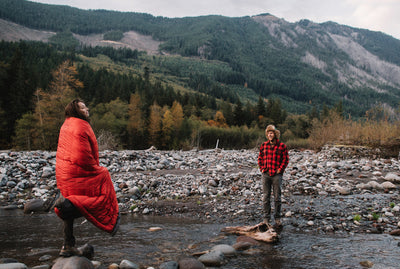How to reduce your waste while camping
This year for National Camp at Home Day, Alisha McDarris from sustainable travel and adventure blog Terradrift offers tips to help you level up your sustainability game and reduce waste at the campsite and beyond. So you can stay classy, not trashy.
Start with proper preparation
If you want to reduce waste on your next outing—whether it’s in your backyard or across the country—if you wait until you get to camp to make your move, you’ve already lost. Successful low- or no-waste camping starts with solid preparation.
Skip the pre-packaged meals and bars
This is a tough one, especially because pre-packaged, store-bought backpacking meals are just so easy, but the packaging they come in is usually single-use and not recyclable or compostable. So for every freeze-dried meal you snag off of store shelves, commit to making one yourself. It’s about doing what you can, not achieving zero-waste perfection.
Use ingredients you already have around the house like noodles, instant rice, or spices and combine them with your favorite protein sources like instant dried beans or, my favorite, textured vegetable protein. Blend together ingredients like oats, dates, nut butters, protein powder, seeds and dried fruit to make your own snack and protein bars. Prepare your own fruit leather and jerky in the oven. Get creative! And after a few experimental recipes, we bet you’ll be way more pleased with the flavor results than with those bland pre-made meals. And if you need a few idea to get you started, I wrote a whole cookbook of plant-based recipes, which you can find here.
Buy in bulk
If you’ll be making your own meals and snacks, call on your local grocery store’s bulk bin. Usually, you can bring a reusable container (for even less waste) to fill with items like instant potatoes or beans, hummus or textured vegetable protein, nuts and dried fruit, even spices and energy bites, all without an ounce of extraneous packaging. If your local grocery doesn’t have a bulk bin section, then buy larger packages of items like rice or trail mix, freeze-dried vegetables or fruit instead of single-serve sizes in order to reduce waste.
Utilize reusable packaging
Zip-top bags are convenient, no doubt, but in most cases, they are single-use items that don’t get recycled (though you can usually recycle clean zip-top bags at your local grocery store’s bag recycling bin). So opt out of single-use whenever possible. Snacks, meal ingredients and more can be stored in reusable silicone zip-top bags, plastic storage containers, or food wraps that can be washed and reused many times.
Opt for snacks in sustainable packaging
We can’t make all of our own snacks all the time. Take nuts, dried fruit, and seeds for example. Fortunately, you can still get waste-free snacks by purchasing from brands that use compostable or biodegradable packaging. Shar, for example, offers trail mix in refillable, recyclable, and compostable cardboard tubes while Sun and Swell packages their snacks, nuts and dried fruit in compostable bags, including single-serves!

Reduce waste at camp
Prepping is at least half the battle if you want to enjoy to a low-waste camping trip. But it doesn’t stop there; keep the good vibes rolling (and the trash bags empty) once you arrive.
Ditch disposables
Save the paper plates for your kid’s pizza party and commit to using reusable plates, utensils and cups when camping. There are plenty of quality and durable mess kits out there and they’re easy to wash and reuse at camp. Plus, they don’t create bags full of trash at the end of every meal. But don’t stop there: swap straws, napkins, and paper towels for reusable and washable items, too.
Skip single use bottles
Instead of bringing along a case of single-use plastic water bottles or even gallon jugs of water, bring a refillable container with a spout or nozzle like a water cube for storing and serving up H2O.
Use a refillable gas tank
You know those little green bottles that fuel your camp stove? Millions end up in landfills every year because they can’t be easily recycled. Upgrade to a small, refillable cylinder like one from Ignik to drastically reduce waste when camping.

Repurpose your water bottle
Skip the wasteful bags of ice (for at least as long as you can) on your next camping trip and use reusable ice packs or make one of your own: The night before you leave, fill your Nalgene or other hard plastic water bottle 3/4 full and stash it in the freezer. In the morning, you’ll have a multipurpose DIY ice pack that also functions as a water bottle as the ice melts. You can even refill the bottle with ice from a beverage dispenser when repacking your cooler on the go.
Utilize refillable and compostable toiletries
If you’re camping at home, this won’t likely be an issue, but if you’re spending more than a day or two farther afield, you might plan to wash up a few times (dishes or yourself). If that’s the case, avoid purchasing travel-size toiletries and soaps and instead utilize reusable and refillable containers and tubes to hold soap, shampoo and more. Also important: Make sure they are biodegradable for the least amount of impact to the natural spaces around you.
Bottom Line
There’s plenty you can do if you’re looking to reduce your waste while camping. All it takes is a bit of planning and preparation, a willingness to try something new, and a touch of creativity and you’re well on your way to producing less waste and enjoying more environmentally-friendly outings. Wander on!




